Individual Reflection: Group Project on Museum Visit and Team Dynamics
VerifiedAdded on 2022/11/24
|9
|2703
|412
Report
AI Summary
This report presents a detailed reflection on a group project focused on a museum visit and presentation preparation. It analyzes the application of Tuckman’s Team Development Model, exploring the forming, storming, norming, performing, and adjourning stages within the team. The report also discusses the application of Goal Setting Theory of motivation, emphasizing clarity, challenge, commitment, feedback, and task complexity. Additionally, it incorporates Sirota's Three-Factor Theory, highlighting equity/fairness, achievement, and camaraderie. The report further delves into the application of the Competing Values Framework (CVF) to assess individual actions and behaviors, analyzing the clan/collaborate, hierarchy/control, adhocracy/create, and market/compete dimensions. The project involved researching Oliver Cromwell and preparing an informative presentation. The report highlights the effectiveness of teamwork, the impact of motivation theories, and the insights gained from applying the CVF to understand team dynamics and individual behaviors.
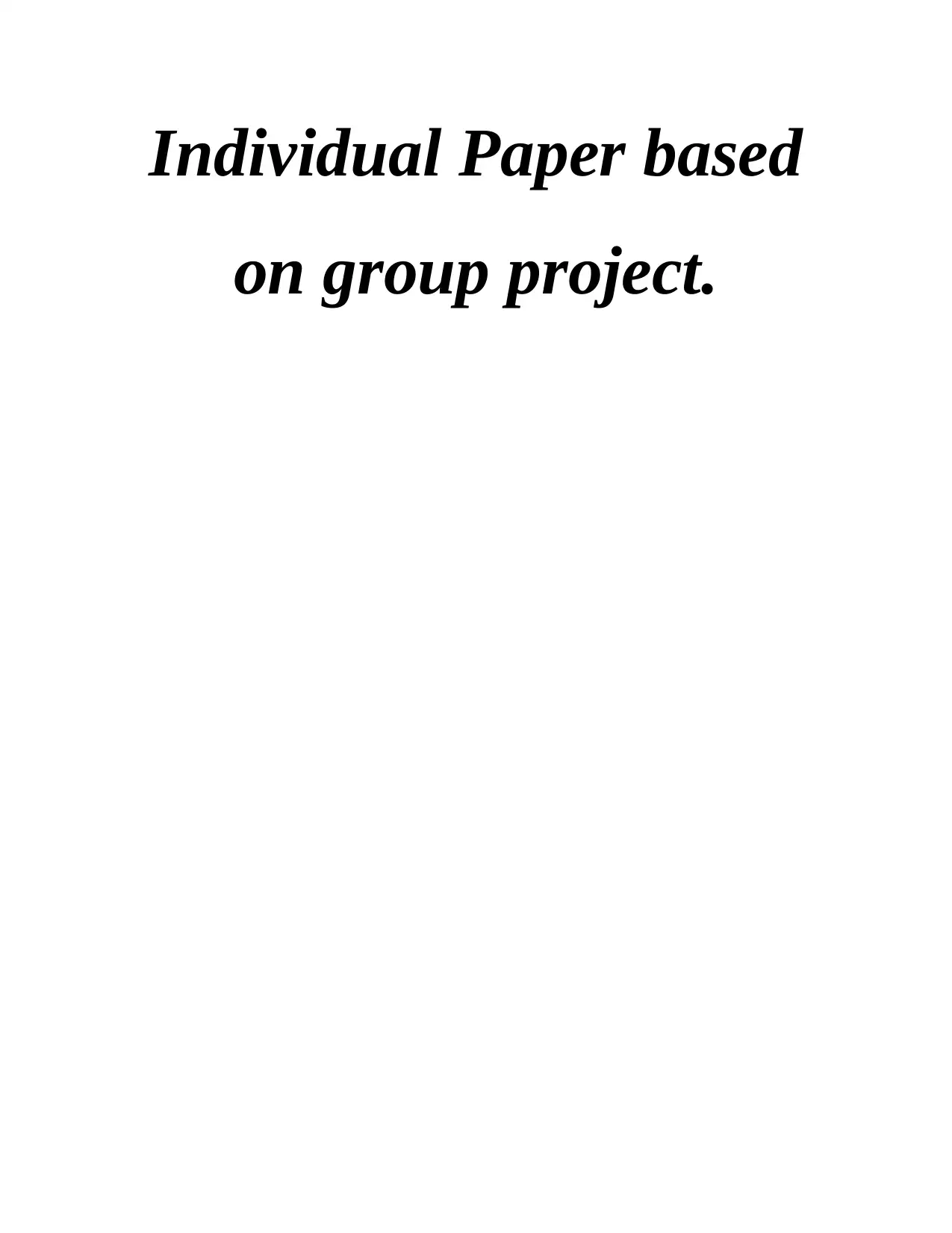
Individual Paper based
on group project.
on group project.
Paraphrase This Document
Need a fresh take? Get an instant paraphrase of this document with our AI Paraphraser
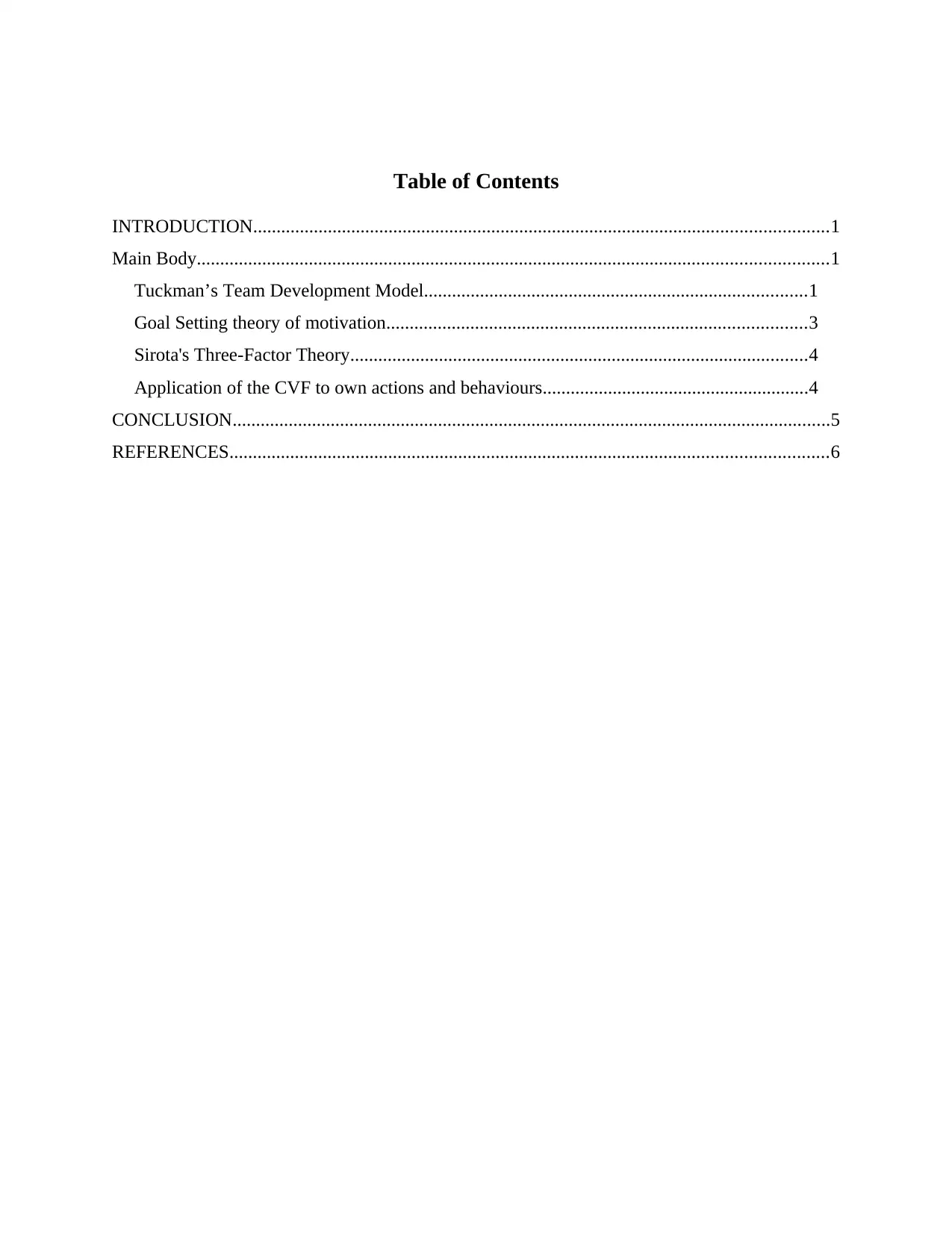
Table of Contents
INTRODUCTION...........................................................................................................................1
Main Body.......................................................................................................................................1
Tuckman’s Team Development Model..................................................................................1
Goal Setting theory of motivation..........................................................................................3
Sirota's Three-Factor Theory..................................................................................................4
Application of the CVF to own actions and behaviours.........................................................4
CONCLUSION................................................................................................................................5
REFERENCES................................................................................................................................6
INTRODUCTION...........................................................................................................................1
Main Body.......................................................................................................................................1
Tuckman’s Team Development Model..................................................................................1
Goal Setting theory of motivation..........................................................................................3
Sirota's Three-Factor Theory..................................................................................................4
Application of the CVF to own actions and behaviours.........................................................4
CONCLUSION................................................................................................................................5
REFERENCES................................................................................................................................6
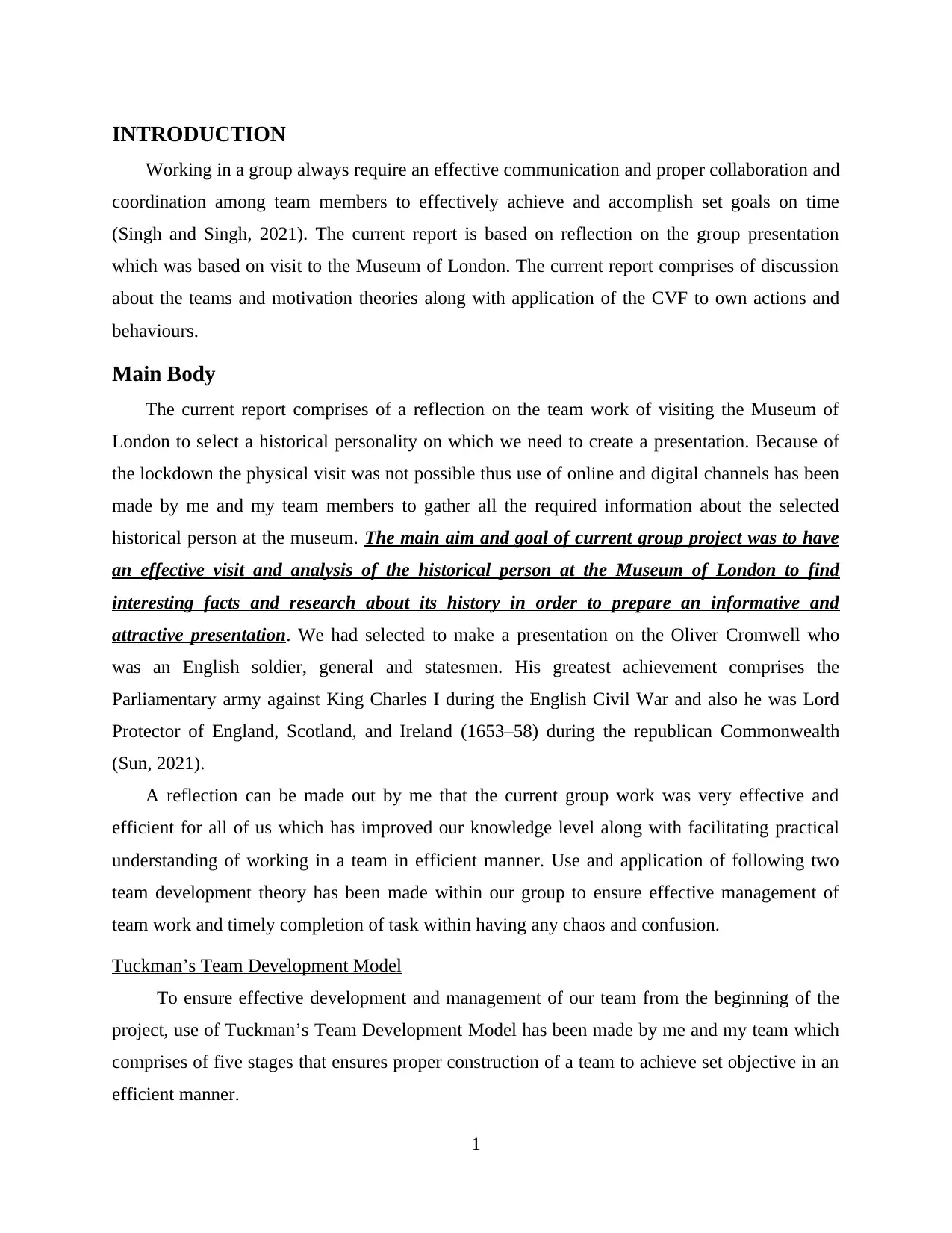
INTRODUCTION
Working in a group always require an effective communication and proper collaboration and
coordination among team members to effectively achieve and accomplish set goals on time
(Singh and Singh, 2021). The current report is based on reflection on the group presentation
which was based on visit to the Museum of London. The current report comprises of discussion
about the teams and motivation theories along with application of the CVF to own actions and
behaviours.
Main Body
The current report comprises of a reflection on the team work of visiting the Museum of
London to select a historical personality on which we need to create a presentation. Because of
the lockdown the physical visit was not possible thus use of online and digital channels has been
made by me and my team members to gather all the required information about the selected
historical person at the museum. The main aim and goal of current group project was to have
an effective visit and analysis of the historical person at the Museum of London to find
interesting facts and research about its history in order to prepare an informative and
attractive presentation. We had selected to make a presentation on the Oliver Cromwell who
was an English soldier, general and statesmen. His greatest achievement comprises the
Parliamentary army against King Charles I during the English Civil War and also he was Lord
Protector of England, Scotland, and Ireland (1653–58) during the republican Commonwealth
(Sun, 2021).
A reflection can be made out by me that the current group work was very effective and
efficient for all of us which has improved our knowledge level along with facilitating practical
understanding of working in a team in efficient manner. Use and application of following two
team development theory has been made within our group to ensure effective management of
team work and timely completion of task within having any chaos and confusion.
Tuckman’s Team Development Model
To ensure effective development and management of our team from the beginning of the
project, use of Tuckman’s Team Development Model has been made by me and my team which
comprises of five stages that ensures proper construction of a team to achieve set objective in an
efficient manner.
1
Working in a group always require an effective communication and proper collaboration and
coordination among team members to effectively achieve and accomplish set goals on time
(Singh and Singh, 2021). The current report is based on reflection on the group presentation
which was based on visit to the Museum of London. The current report comprises of discussion
about the teams and motivation theories along with application of the CVF to own actions and
behaviours.
Main Body
The current report comprises of a reflection on the team work of visiting the Museum of
London to select a historical personality on which we need to create a presentation. Because of
the lockdown the physical visit was not possible thus use of online and digital channels has been
made by me and my team members to gather all the required information about the selected
historical person at the museum. The main aim and goal of current group project was to have
an effective visit and analysis of the historical person at the Museum of London to find
interesting facts and research about its history in order to prepare an informative and
attractive presentation. We had selected to make a presentation on the Oliver Cromwell who
was an English soldier, general and statesmen. His greatest achievement comprises the
Parliamentary army against King Charles I during the English Civil War and also he was Lord
Protector of England, Scotland, and Ireland (1653–58) during the republican Commonwealth
(Sun, 2021).
A reflection can be made out by me that the current group work was very effective and
efficient for all of us which has improved our knowledge level along with facilitating practical
understanding of working in a team in efficient manner. Use and application of following two
team development theory has been made within our group to ensure effective management of
team work and timely completion of task within having any chaos and confusion.
Tuckman’s Team Development Model
To ensure effective development and management of our team from the beginning of the
project, use of Tuckman’s Team Development Model has been made by me and my team which
comprises of five stages that ensures proper construction of a team to achieve set objective in an
efficient manner.
1
⊘ This is a preview!⊘
Do you want full access?
Subscribe today to unlock all pages.

Trusted by 1+ million students worldwide
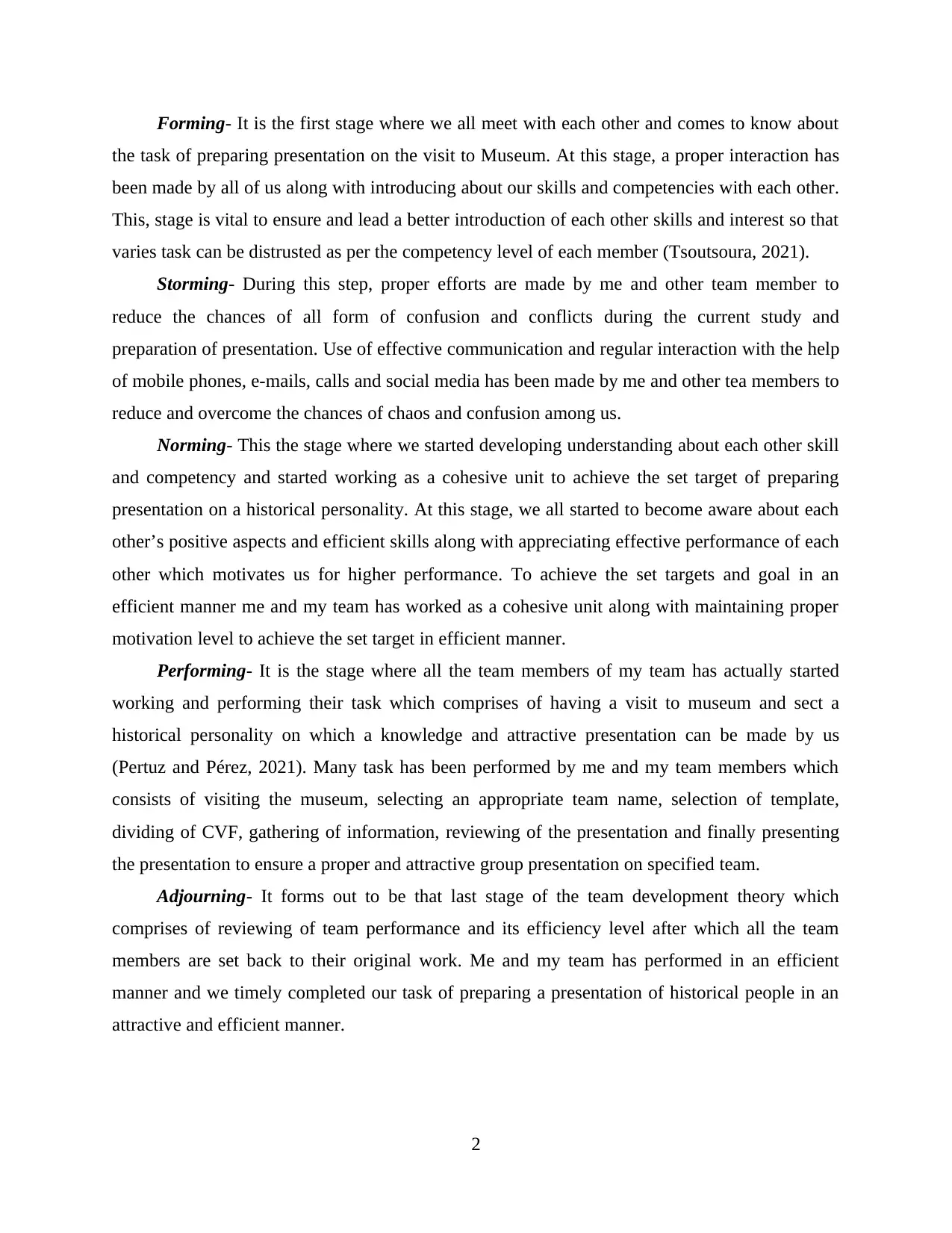
Forming- It is the first stage where we all meet with each other and comes to know about
the task of preparing presentation on the visit to Museum. At this stage, a proper interaction has
been made by all of us along with introducing about our skills and competencies with each other.
This, stage is vital to ensure and lead a better introduction of each other skills and interest so that
varies task can be distrusted as per the competency level of each member (Tsoutsoura, 2021).
Storming- During this step, proper efforts are made by me and other team member to
reduce the chances of all form of confusion and conflicts during the current study and
preparation of presentation. Use of effective communication and regular interaction with the help
of mobile phones, e-mails, calls and social media has been made by me and other tea members to
reduce and overcome the chances of chaos and confusion among us.
Norming- This the stage where we started developing understanding about each other skill
and competency and started working as a cohesive unit to achieve the set target of preparing
presentation on a historical personality. At this stage, we all started to become aware about each
other’s positive aspects and efficient skills along with appreciating effective performance of each
other which motivates us for higher performance. To achieve the set targets and goal in an
efficient manner me and my team has worked as a cohesive unit along with maintaining proper
motivation level to achieve the set target in efficient manner.
Performing- It is the stage where all the team members of my team has actually started
working and performing their task which comprises of having a visit to museum and sect a
historical personality on which a knowledge and attractive presentation can be made by us
(Pertuz and Pérez, 2021). Many task has been performed by me and my team members which
consists of visiting the museum, selecting an appropriate team name, selection of template,
dividing of CVF, gathering of information, reviewing of the presentation and finally presenting
the presentation to ensure a proper and attractive group presentation on specified team.
Adjourning- It forms out to be that last stage of the team development theory which
comprises of reviewing of team performance and its efficiency level after which all the team
members are set back to their original work. Me and my team has performed in an efficient
manner and we timely completed our task of preparing a presentation of historical people in an
attractive and efficient manner.
2
the task of preparing presentation on the visit to Museum. At this stage, a proper interaction has
been made by all of us along with introducing about our skills and competencies with each other.
This, stage is vital to ensure and lead a better introduction of each other skills and interest so that
varies task can be distrusted as per the competency level of each member (Tsoutsoura, 2021).
Storming- During this step, proper efforts are made by me and other team member to
reduce the chances of all form of confusion and conflicts during the current study and
preparation of presentation. Use of effective communication and regular interaction with the help
of mobile phones, e-mails, calls and social media has been made by me and other tea members to
reduce and overcome the chances of chaos and confusion among us.
Norming- This the stage where we started developing understanding about each other skill
and competency and started working as a cohesive unit to achieve the set target of preparing
presentation on a historical personality. At this stage, we all started to become aware about each
other’s positive aspects and efficient skills along with appreciating effective performance of each
other which motivates us for higher performance. To achieve the set targets and goal in an
efficient manner me and my team has worked as a cohesive unit along with maintaining proper
motivation level to achieve the set target in efficient manner.
Performing- It is the stage where all the team members of my team has actually started
working and performing their task which comprises of having a visit to museum and sect a
historical personality on which a knowledge and attractive presentation can be made by us
(Pertuz and Pérez, 2021). Many task has been performed by me and my team members which
consists of visiting the museum, selecting an appropriate team name, selection of template,
dividing of CVF, gathering of information, reviewing of the presentation and finally presenting
the presentation to ensure a proper and attractive group presentation on specified team.
Adjourning- It forms out to be that last stage of the team development theory which
comprises of reviewing of team performance and its efficiency level after which all the team
members are set back to their original work. Me and my team has performed in an efficient
manner and we timely completed our task of preparing a presentation of historical people in an
attractive and efficient manner.
2
Paraphrase This Document
Need a fresh take? Get an instant paraphrase of this document with our AI Paraphraser
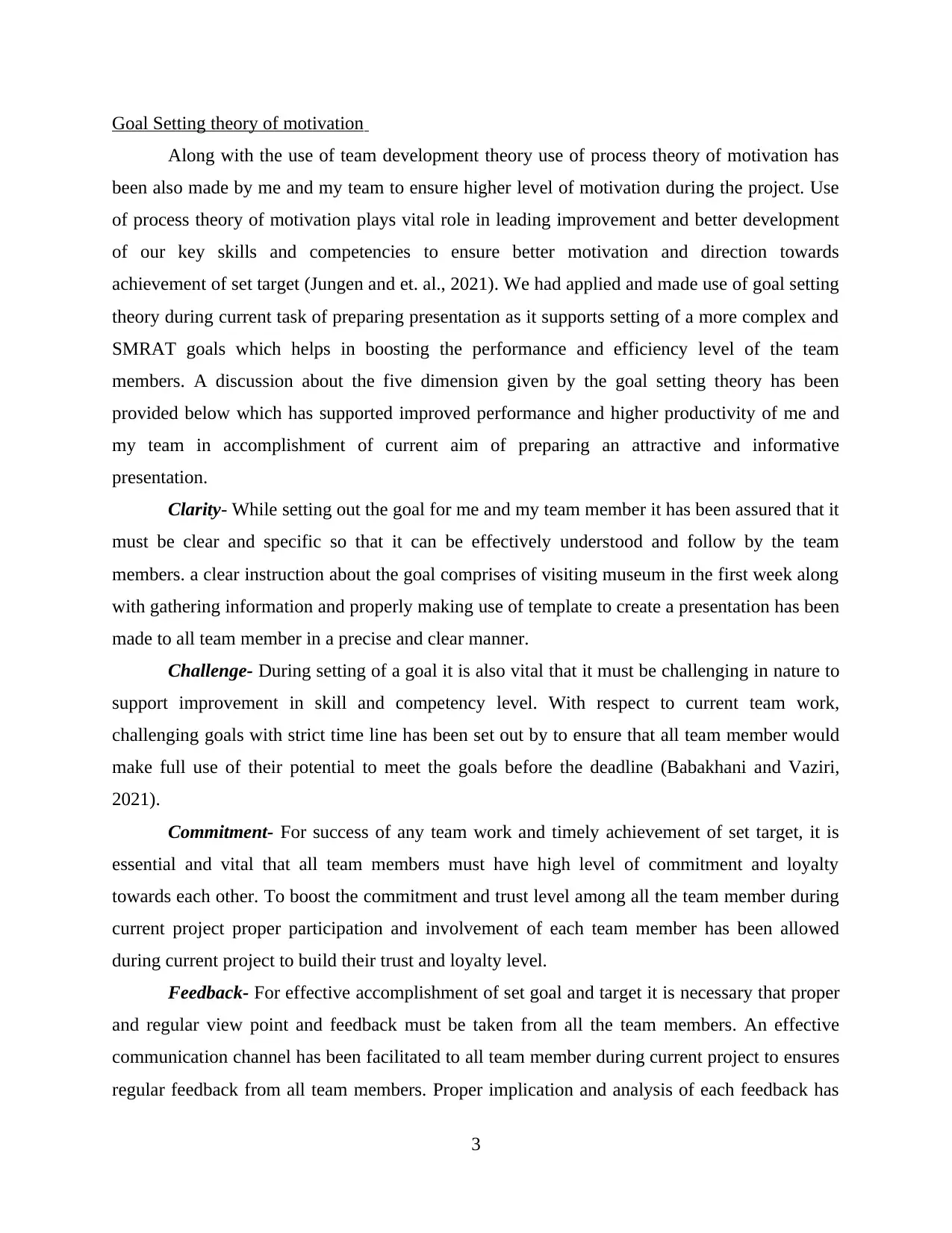
Goal Setting theory of motivation
Along with the use of team development theory use of process theory of motivation has
been also made by me and my team to ensure higher level of motivation during the project. Use
of process theory of motivation plays vital role in leading improvement and better development
of our key skills and competencies to ensure better motivation and direction towards
achievement of set target (Jungen and et. al., 2021). We had applied and made use of goal setting
theory during current task of preparing presentation as it supports setting of a more complex and
SMRAT goals which helps in boosting the performance and efficiency level of the team
members. A discussion about the five dimension given by the goal setting theory has been
provided below which has supported improved performance and higher productivity of me and
my team in accomplishment of current aim of preparing an attractive and informative
presentation.
Clarity- While setting out the goal for me and my team member it has been assured that it
must be clear and specific so that it can be effectively understood and follow by the team
members. a clear instruction about the goal comprises of visiting museum in the first week along
with gathering information and properly making use of template to create a presentation has been
made to all team member in a precise and clear manner.
Challenge- During setting of a goal it is also vital that it must be challenging in nature to
support improvement in skill and competency level. With respect to current team work,
challenging goals with strict time line has been set out by to ensure that all team member would
make full use of their potential to meet the goals before the deadline (Babakhani and Vaziri,
2021).
Commitment- For success of any team work and timely achievement of set target, it is
essential and vital that all team members must have high level of commitment and loyalty
towards each other. To boost the commitment and trust level among all the team member during
current project proper participation and involvement of each team member has been allowed
during current project to build their trust and loyalty level.
Feedback- For effective accomplishment of set goal and target it is necessary that proper
and regular view point and feedback must be taken from all the team members. An effective
communication channel has been facilitated to all team member during current project to ensures
regular feedback from all team members. Proper implication and analysis of each feedback has
3
Along with the use of team development theory use of process theory of motivation has
been also made by me and my team to ensure higher level of motivation during the project. Use
of process theory of motivation plays vital role in leading improvement and better development
of our key skills and competencies to ensure better motivation and direction towards
achievement of set target (Jungen and et. al., 2021). We had applied and made use of goal setting
theory during current task of preparing presentation as it supports setting of a more complex and
SMRAT goals which helps in boosting the performance and efficiency level of the team
members. A discussion about the five dimension given by the goal setting theory has been
provided below which has supported improved performance and higher productivity of me and
my team in accomplishment of current aim of preparing an attractive and informative
presentation.
Clarity- While setting out the goal for me and my team member it has been assured that it
must be clear and specific so that it can be effectively understood and follow by the team
members. a clear instruction about the goal comprises of visiting museum in the first week along
with gathering information and properly making use of template to create a presentation has been
made to all team member in a precise and clear manner.
Challenge- During setting of a goal it is also vital that it must be challenging in nature to
support improvement in skill and competency level. With respect to current team work,
challenging goals with strict time line has been set out by to ensure that all team member would
make full use of their potential to meet the goals before the deadline (Babakhani and Vaziri,
2021).
Commitment- For success of any team work and timely achievement of set target, it is
essential and vital that all team members must have high level of commitment and loyalty
towards each other. To boost the commitment and trust level among all the team member during
current project proper participation and involvement of each team member has been allowed
during current project to build their trust and loyalty level.
Feedback- For effective accomplishment of set goal and target it is necessary that proper
and regular view point and feedback must be taken from all the team members. An effective
communication channel has been facilitated to all team member during current project to ensures
regular feedback from all team members. Proper implication and analysis of each feedback has
3
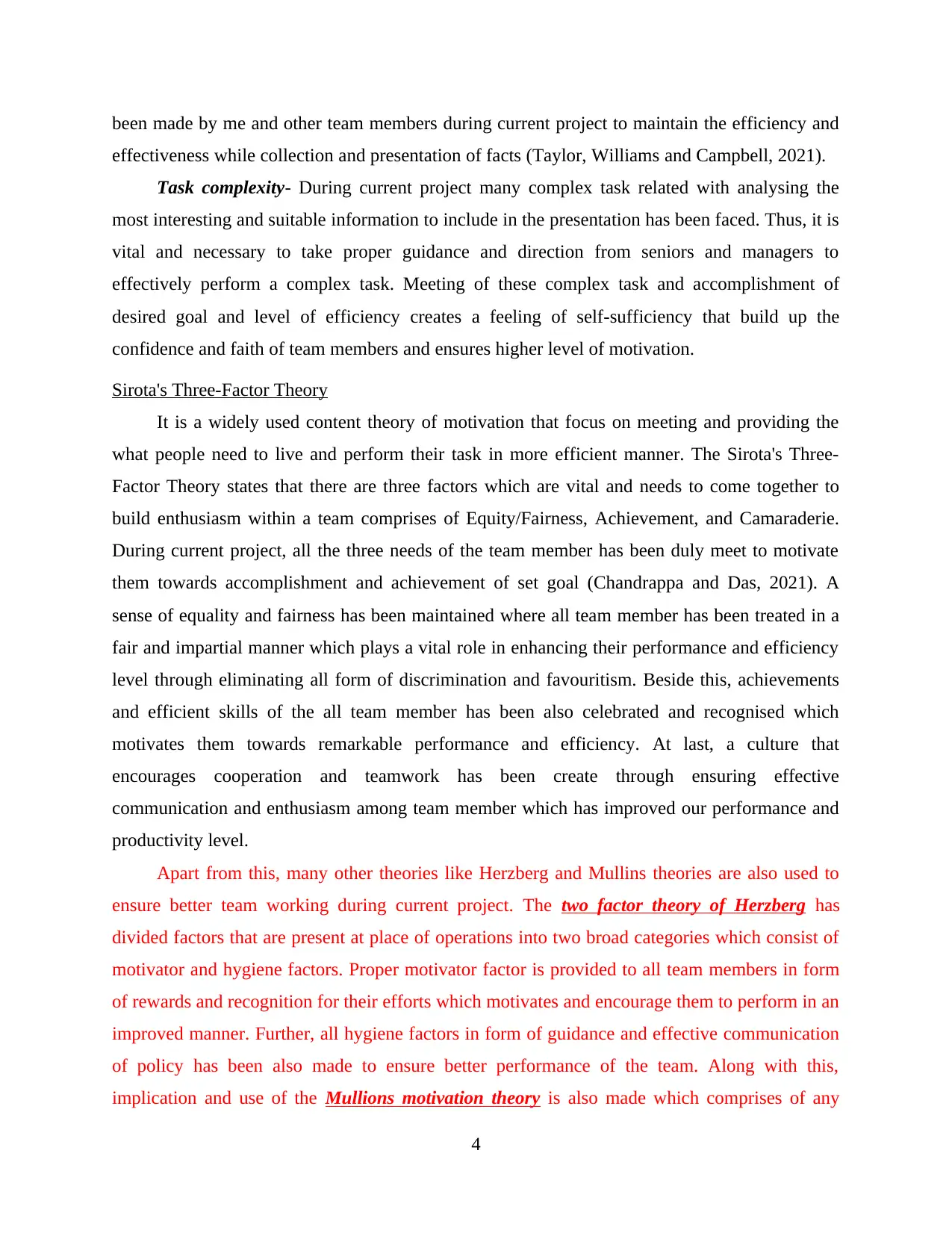
been made by me and other team members during current project to maintain the efficiency and
effectiveness while collection and presentation of facts (Taylor, Williams and Campbell, 2021).
Task complexity- During current project many complex task related with analysing the
most interesting and suitable information to include in the presentation has been faced. Thus, it is
vital and necessary to take proper guidance and direction from seniors and managers to
effectively perform a complex task. Meeting of these complex task and accomplishment of
desired goal and level of efficiency creates a feeling of self-sufficiency that build up the
confidence and faith of team members and ensures higher level of motivation.
Sirota's Three-Factor Theory
It is a widely used content theory of motivation that focus on meeting and providing the
what people need to live and perform their task in more efficient manner. The Sirota's Three-
Factor Theory states that there are three factors which are vital and needs to come together to
build enthusiasm within a team comprises of Equity/Fairness, Achievement, and Camaraderie.
During current project, all the three needs of the team member has been duly meet to motivate
them towards accomplishment and achievement of set goal (Chandrappa and Das, 2021). A
sense of equality and fairness has been maintained where all team member has been treated in a
fair and impartial manner which plays a vital role in enhancing their performance and efficiency
level through eliminating all form of discrimination and favouritism. Beside this, achievements
and efficient skills of the all team member has been also celebrated and recognised which
motivates them towards remarkable performance and efficiency. At last, a culture that
encourages cooperation and teamwork has been create through ensuring effective
communication and enthusiasm among team member which has improved our performance and
productivity level.
Apart from this, many other theories like Herzberg and Mullins theories are also used to
ensure better team working during current project. The two factor theory of Herzberg has
divided factors that are present at place of operations into two broad categories which consist of
motivator and hygiene factors. Proper motivator factor is provided to all team members in form
of rewards and recognition for their efforts which motivates and encourage them to perform in an
improved manner. Further, all hygiene factors in form of guidance and effective communication
of policy has been also made to ensure better performance of the team. Along with this,
implication and use of the Mullions motivation theory is also made which comprises of any
4
effectiveness while collection and presentation of facts (Taylor, Williams and Campbell, 2021).
Task complexity- During current project many complex task related with analysing the
most interesting and suitable information to include in the presentation has been faced. Thus, it is
vital and necessary to take proper guidance and direction from seniors and managers to
effectively perform a complex task. Meeting of these complex task and accomplishment of
desired goal and level of efficiency creates a feeling of self-sufficiency that build up the
confidence and faith of team members and ensures higher level of motivation.
Sirota's Three-Factor Theory
It is a widely used content theory of motivation that focus on meeting and providing the
what people need to live and perform their task in more efficient manner. The Sirota's Three-
Factor Theory states that there are three factors which are vital and needs to come together to
build enthusiasm within a team comprises of Equity/Fairness, Achievement, and Camaraderie.
During current project, all the three needs of the team member has been duly meet to motivate
them towards accomplishment and achievement of set goal (Chandrappa and Das, 2021). A
sense of equality and fairness has been maintained where all team member has been treated in a
fair and impartial manner which plays a vital role in enhancing their performance and efficiency
level through eliminating all form of discrimination and favouritism. Beside this, achievements
and efficient skills of the all team member has been also celebrated and recognised which
motivates them towards remarkable performance and efficiency. At last, a culture that
encourages cooperation and teamwork has been create through ensuring effective
communication and enthusiasm among team member which has improved our performance and
productivity level.
Apart from this, many other theories like Herzberg and Mullins theories are also used to
ensure better team working during current project. The two factor theory of Herzberg has
divided factors that are present at place of operations into two broad categories which consist of
motivator and hygiene factors. Proper motivator factor is provided to all team members in form
of rewards and recognition for their efforts which motivates and encourage them to perform in an
improved manner. Further, all hygiene factors in form of guidance and effective communication
of policy has been also made to ensure better performance of the team. Along with this,
implication and use of the Mullions motivation theory is also made which comprises of any
4
⊘ This is a preview!⊘
Do you want full access?
Subscribe today to unlock all pages.

Trusted by 1+ million students worldwide
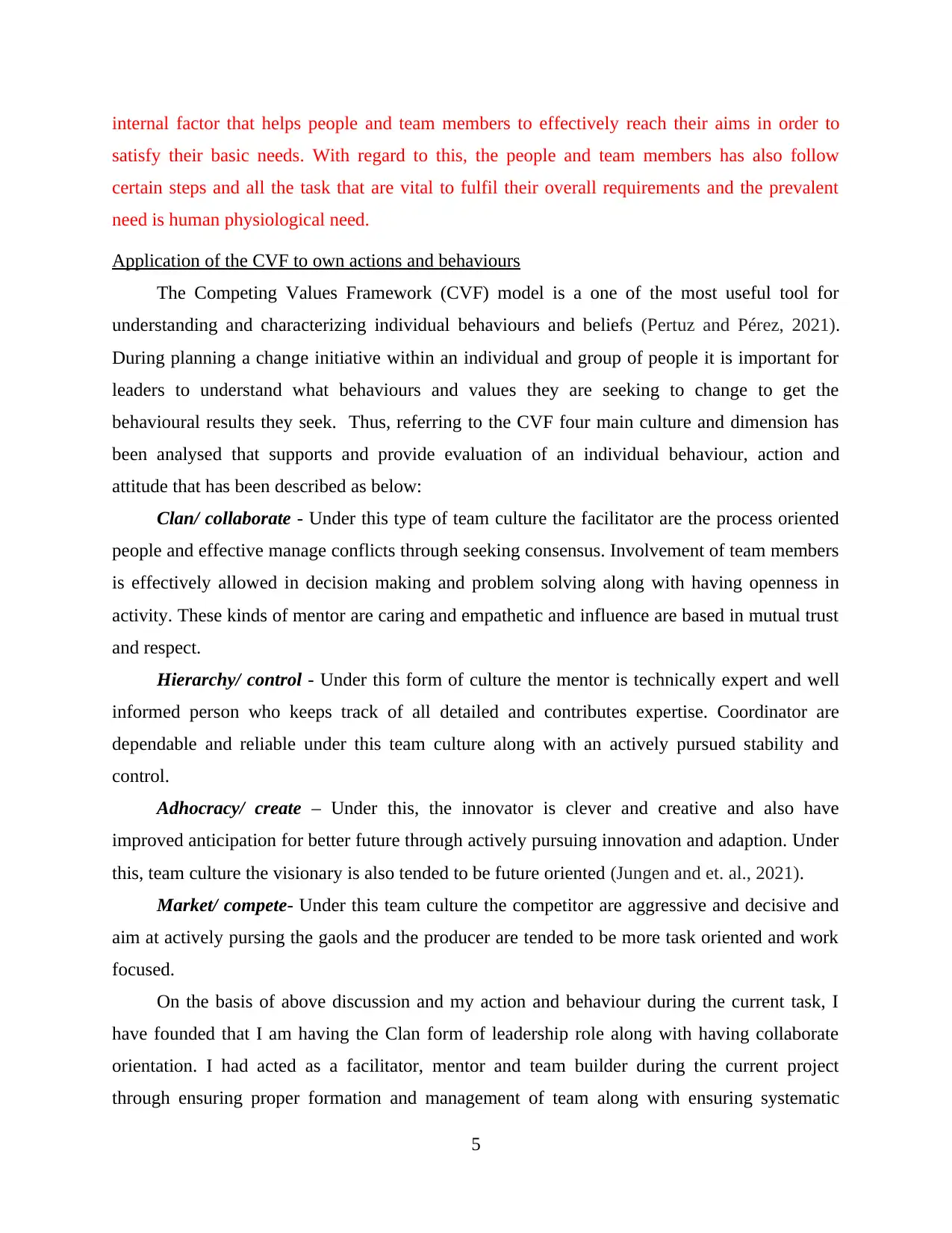
internal factor that helps people and team members to effectively reach their aims in order to
satisfy their basic needs. With regard to this, the people and team members has also follow
certain steps and all the task that are vital to fulfil their overall requirements and the prevalent
need is human physiological need.
Application of the CVF to own actions and behaviours
The Competing Values Framework (CVF) model is a one of the most useful tool for
understanding and characterizing individual behaviours and beliefs (Pertuz and Pérez, 2021).
During planning a change initiative within an individual and group of people it is important for
leaders to understand what behaviours and values they are seeking to change to get the
behavioural results they seek. Thus, referring to the CVF four main culture and dimension has
been analysed that supports and provide evaluation of an individual behaviour, action and
attitude that has been described as below:
Clan/ collaborate - Under this type of team culture the facilitator are the process oriented
people and effective manage conflicts through seeking consensus. Involvement of team members
is effectively allowed in decision making and problem solving along with having openness in
activity. These kinds of mentor are caring and empathetic and influence are based in mutual trust
and respect.
Hierarchy/ control - Under this form of culture the mentor is technically expert and well
informed person who keeps track of all detailed and contributes expertise. Coordinator are
dependable and reliable under this team culture along with an actively pursued stability and
control.
Adhocracy/ create – Under this, the innovator is clever and creative and also have
improved anticipation for better future through actively pursuing innovation and adaption. Under
this, team culture the visionary is also tended to be future oriented (Jungen and et. al., 2021).
Market/ compete- Under this team culture the competitor are aggressive and decisive and
aim at actively pursing the gaols and the producer are tended to be more task oriented and work
focused.
On the basis of above discussion and my action and behaviour during the current task, I
have founded that I am having the Clan form of leadership role along with having collaborate
orientation. I had acted as a facilitator, mentor and team builder during the current project
through ensuring proper formation and management of team along with ensuring systematic
5
satisfy their basic needs. With regard to this, the people and team members has also follow
certain steps and all the task that are vital to fulfil their overall requirements and the prevalent
need is human physiological need.
Application of the CVF to own actions and behaviours
The Competing Values Framework (CVF) model is a one of the most useful tool for
understanding and characterizing individual behaviours and beliefs (Pertuz and Pérez, 2021).
During planning a change initiative within an individual and group of people it is important for
leaders to understand what behaviours and values they are seeking to change to get the
behavioural results they seek. Thus, referring to the CVF four main culture and dimension has
been analysed that supports and provide evaluation of an individual behaviour, action and
attitude that has been described as below:
Clan/ collaborate - Under this type of team culture the facilitator are the process oriented
people and effective manage conflicts through seeking consensus. Involvement of team members
is effectively allowed in decision making and problem solving along with having openness in
activity. These kinds of mentor are caring and empathetic and influence are based in mutual trust
and respect.
Hierarchy/ control - Under this form of culture the mentor is technically expert and well
informed person who keeps track of all detailed and contributes expertise. Coordinator are
dependable and reliable under this team culture along with an actively pursued stability and
control.
Adhocracy/ create – Under this, the innovator is clever and creative and also have
improved anticipation for better future through actively pursuing innovation and adaption. Under
this, team culture the visionary is also tended to be future oriented (Jungen and et. al., 2021).
Market/ compete- Under this team culture the competitor are aggressive and decisive and
aim at actively pursing the gaols and the producer are tended to be more task oriented and work
focused.
On the basis of above discussion and my action and behaviour during the current task, I
have founded that I am having the Clan form of leadership role along with having collaborate
orientation. I had acted as a facilitator, mentor and team builder during the current project
through ensuring proper formation and management of team along with ensuring systematic
5
Paraphrase This Document
Need a fresh take? Get an instant paraphrase of this document with our AI Paraphraser
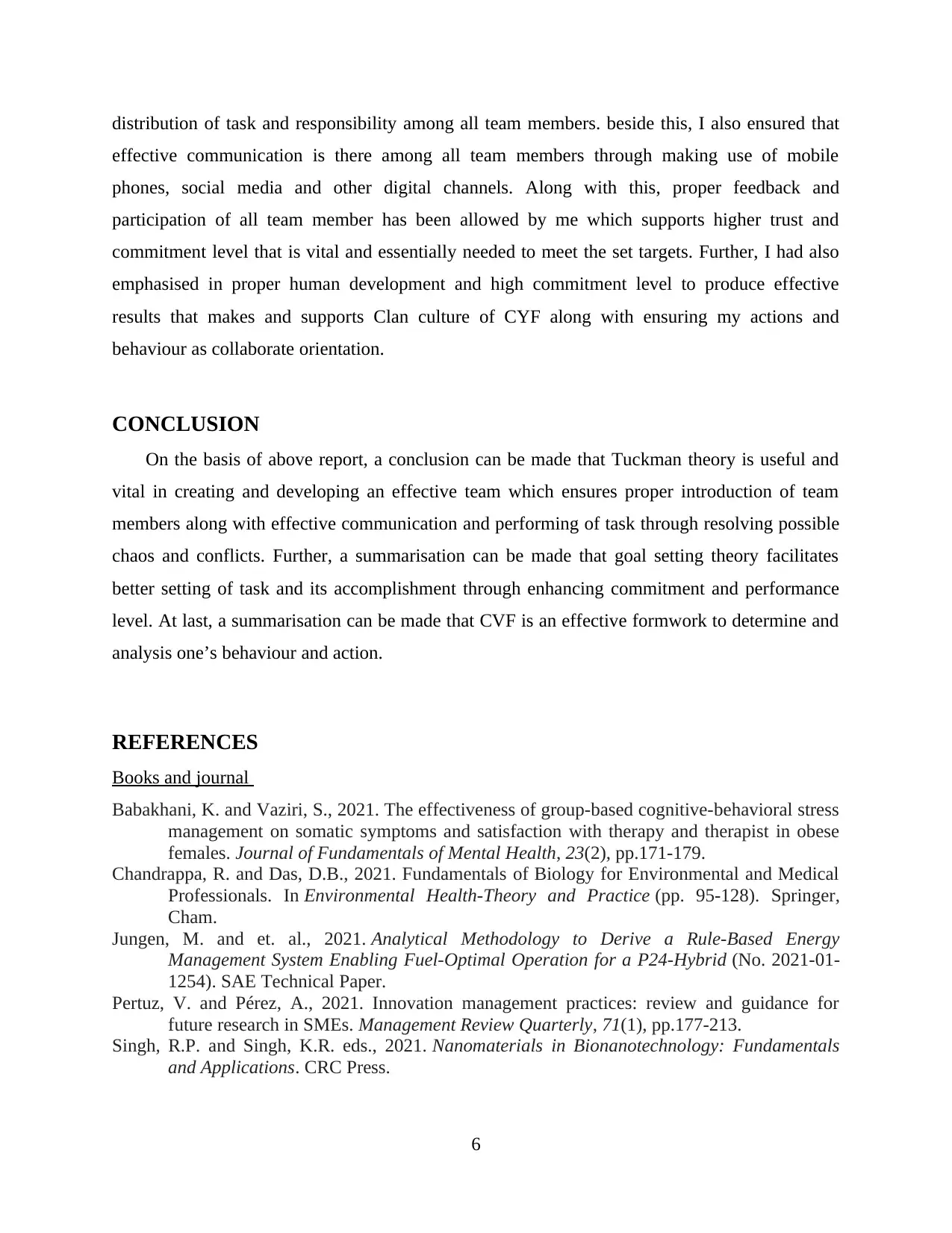
distribution of task and responsibility among all team members. beside this, I also ensured that
effective communication is there among all team members through making use of mobile
phones, social media and other digital channels. Along with this, proper feedback and
participation of all team member has been allowed by me which supports higher trust and
commitment level that is vital and essentially needed to meet the set targets. Further, I had also
emphasised in proper human development and high commitment level to produce effective
results that makes and supports Clan culture of CYF along with ensuring my actions and
behaviour as collaborate orientation.
CONCLUSION
On the basis of above report, a conclusion can be made that Tuckman theory is useful and
vital in creating and developing an effective team which ensures proper introduction of team
members along with effective communication and performing of task through resolving possible
chaos and conflicts. Further, a summarisation can be made that goal setting theory facilitates
better setting of task and its accomplishment through enhancing commitment and performance
level. At last, a summarisation can be made that CVF is an effective formwork to determine and
analysis one’s behaviour and action.
REFERENCES
Books and journal
Babakhani, K. and Vaziri, S., 2021. The effectiveness of group-based cognitive-behavioral stress
management on somatic symptoms and satisfaction with therapy and therapist in obese
females. Journal of Fundamentals of Mental Health, 23(2), pp.171-179.
Chandrappa, R. and Das, D.B., 2021. Fundamentals of Biology for Environmental and Medical
Professionals. In Environmental Health-Theory and Practice (pp. 95-128). Springer,
Cham.
Jungen, M. and et. al., 2021. Analytical Methodology to Derive a Rule-Based Energy
Management System Enabling Fuel-Optimal Operation for a P24-Hybrid (No. 2021-01-
1254). SAE Technical Paper.
Pertuz, V. and Pérez, A., 2021. Innovation management practices: review and guidance for
future research in SMEs. Management Review Quarterly, 71(1), pp.177-213.
Singh, R.P. and Singh, K.R. eds., 2021. Nanomaterials in Bionanotechnology: Fundamentals
and Applications. CRC Press.
6
effective communication is there among all team members through making use of mobile
phones, social media and other digital channels. Along with this, proper feedback and
participation of all team member has been allowed by me which supports higher trust and
commitment level that is vital and essentially needed to meet the set targets. Further, I had also
emphasised in proper human development and high commitment level to produce effective
results that makes and supports Clan culture of CYF along with ensuring my actions and
behaviour as collaborate orientation.
CONCLUSION
On the basis of above report, a conclusion can be made that Tuckman theory is useful and
vital in creating and developing an effective team which ensures proper introduction of team
members along with effective communication and performing of task through resolving possible
chaos and conflicts. Further, a summarisation can be made that goal setting theory facilitates
better setting of task and its accomplishment through enhancing commitment and performance
level. At last, a summarisation can be made that CVF is an effective formwork to determine and
analysis one’s behaviour and action.
REFERENCES
Books and journal
Babakhani, K. and Vaziri, S., 2021. The effectiveness of group-based cognitive-behavioral stress
management on somatic symptoms and satisfaction with therapy and therapist in obese
females. Journal of Fundamentals of Mental Health, 23(2), pp.171-179.
Chandrappa, R. and Das, D.B., 2021. Fundamentals of Biology for Environmental and Medical
Professionals. In Environmental Health-Theory and Practice (pp. 95-128). Springer,
Cham.
Jungen, M. and et. al., 2021. Analytical Methodology to Derive a Rule-Based Energy
Management System Enabling Fuel-Optimal Operation for a P24-Hybrid (No. 2021-01-
1254). SAE Technical Paper.
Pertuz, V. and Pérez, A., 2021. Innovation management practices: review and guidance for
future research in SMEs. Management Review Quarterly, 71(1), pp.177-213.
Singh, R.P. and Singh, K.R. eds., 2021. Nanomaterials in Bionanotechnology: Fundamentals
and Applications. CRC Press.
6
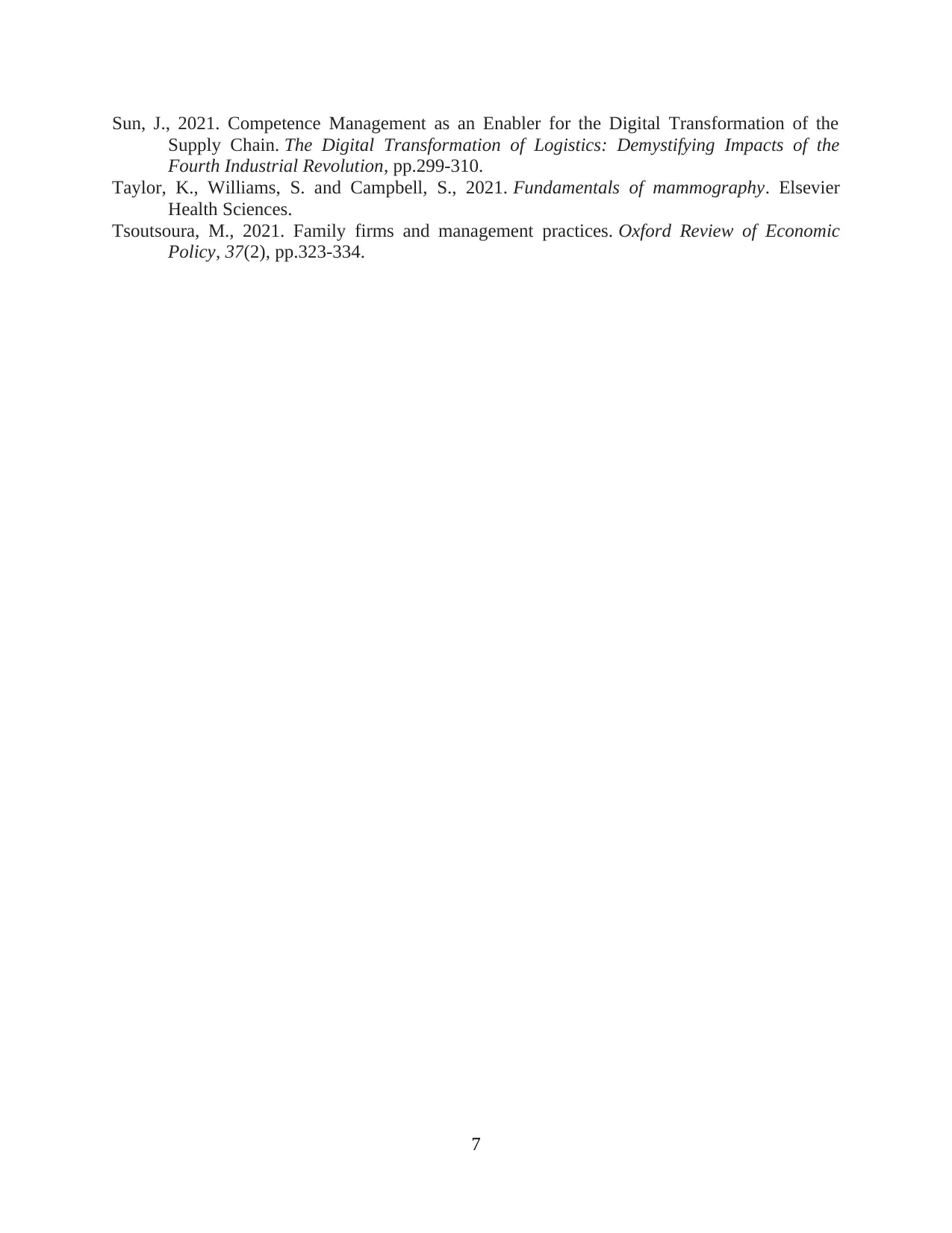
Sun, J., 2021. Competence Management as an Enabler for the Digital Transformation of the
Supply Chain. The Digital Transformation of Logistics: Demystifying Impacts of the
Fourth Industrial Revolution, pp.299-310.
Taylor, K., Williams, S. and Campbell, S., 2021. Fundamentals of mammography. Elsevier
Health Sciences.
Tsoutsoura, M., 2021. Family firms and management practices. Oxford Review of Economic
Policy, 37(2), pp.323-334.
7
Supply Chain. The Digital Transformation of Logistics: Demystifying Impacts of the
Fourth Industrial Revolution, pp.299-310.
Taylor, K., Williams, S. and Campbell, S., 2021. Fundamentals of mammography. Elsevier
Health Sciences.
Tsoutsoura, M., 2021. Family firms and management practices. Oxford Review of Economic
Policy, 37(2), pp.323-334.
7
⊘ This is a preview!⊘
Do you want full access?
Subscribe today to unlock all pages.

Trusted by 1+ million students worldwide
1 out of 9
Related Documents
Your All-in-One AI-Powered Toolkit for Academic Success.
+13062052269
info@desklib.com
Available 24*7 on WhatsApp / Email
![[object Object]](/_next/static/media/star-bottom.7253800d.svg)
Unlock your academic potential
Copyright © 2020–2025 A2Z Services. All Rights Reserved. Developed and managed by ZUCOL.




